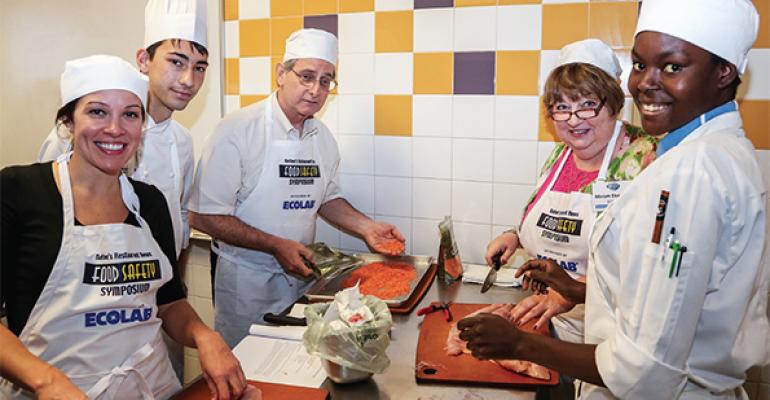Restaurant food safety practices and procedures are no longer just the realm of supply chain executives or back-of-the-house employees.
Food safety has become top of mind for consumers, and many of them are concerned, quick to judge and can be furious when natural disasters, water supply issues or outbreaks challenge restaurants. Conversations on social media, along with an increasing number of vocal food activists, are helping to feed what can quickly become a frenzy.
Tactics to keep restaurants and customers safe, both from an operational standpoint and a brand marketing perspective, were the key takeaways at this year’s Food Safety Symposium in Newport, R.I. The two-day conference is an invite-only event sponsored by Ecolab and produced by Nation’s Restaurant News.
Nearly 40 food safety professionals, as well as experts on supply chain, legal matters and social communication, discussed ways foodservice operations can build systems and communicate action plans aimed at keeping employees and guests safe.
Attendee and panelist Jorge Hernandez, senior vice president, food safety and quality assurance at US Foods, best summed up the changing environment for foodservice safety: “It used to be behind closed doors; now it’s in the public, and it can hit you hard.”
Opening keynote speaker Dr. Benjamin Chapman, assistant professor and food safety extension specialist at North Carolina State University, discussed where food safety and social media intersect.
“If you are sitting in the audience saying I don’t get social media, I don’t need to know about it, you are looking into the cannon to see if it’s loaded,” Chapman said. “The traditional media process does not exist today as it did in the past.”
Restaurants need to listen, not hide from mistakes, engage the audience and provide evidence of correction or safety — all via social media channels — when food becomes suspect or confirmed instances of sickness, food supply issues or safety issues arise.
A new breed of “food e-vangelists,” Chapman said, has become extremely active in spotting potential issues at restaurants or food brands and spreading the word through their own networks, some of which total in the millions. These socially committed consumers tend to be female, under the age of 35 years old, have families — and generate about 1.6 million conversations about food every week on Facebook and Twitter.
But this group is also open to conversations from food brands — especially if they shed light on practices, supply chain and employee or guest safety.
“They are looking for engagement,” Chapman said. “They do not see themselves as activists; it is not as simple as that. They are passionate about food. They want to be seen as someone who is passionate, who is trying to change the food system.”
Chapman highlighted the case of a mold outbreak last year in some U.S. containers of Chobani yogurt. The food manufacturer reportedly at first said the mold is unlikely to cause ill effects, but then undertook a voluntary recall of certain products after reports of 300 people getting ill were made public. Chobani has said all products are now safe and tests are completed often.
Chapman said the yogurt manufacturer and consumer-favorite brand missed an opportunity to drive trust and engagement among customers. “I would have immediately been a partner in the discussion. Instead of responding to complaints, I would begin to tell the story, and in detail,” he said. “You might as well steer the story. Don’t get me wrong, this isn’t a feel good discussion, but it helps you be part of the story.”
Staying on top of information
(Continued from page 1)
Outside of consumer branding concerns, which shouldn’t be downplayed, as they can lead to business failures or millions of dollars in legal fees, implementing back-of-the-house operations designed to prevent problems with restaurant food supply or safety is the best way to address challenges.
Attendees discussed how to source data and information to stay on top of potential health scares, from compromised water supplies to employee or guest illness, like cases of norovirus.
Dustin Dixon, corporate vice president, food safety and quality assurance, at Bob Evans Farms spoke about the importance of on-the-ready action and communications plans, staff training and solid relationships with suppliers, distributors and local health departments.
Bob Evans had faced a compromised water supply when a chemical spill in West Virginia affected areas where some restaurant locations operate. “Bob Evans has a check list; we had it in place before West Virginia, and we still learned a lot,” Dixon said. “‘Can open’ and ‘ready to open’ are two different things.”
When it comes to a virus outbreak, like that of norovirus, prevention is key — with standard items like washing hands and keeping sick employees home — but response is also critical.
“It’s not if, but when,” said Eric Martin, director of food safety at Texas Roadhouse. “It’s an anxiety attack.”
Beyond prevention, Martin suggests restaurant chains and foodservice providers identify and train first responders at the unit level, have access to the best tools to handle cleaning and disinfection, have a professional response team on speed dial, and use social or other online data to stay alert to health department alerts or social media chatter on outbreaks.
Contact Sarah Lockyer at [email protected].
Follow her on Twitter: @slockyerNRN




